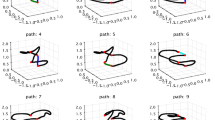Abstract
In this paper, we propose a hybrid postural control approach taking advantage of data-driven and goal-oriented methods while overcoming their limitations. In particular, we take advantage of the latent space characterizing a given motion database. We introduce a motion constraint operating in the latent space to benefit from its much smaller dimension compared to the joint space. This allows its transparent integration into a Prioritized Inverse Kinematics framework. If its priority is high the constraint may restrict the solution to lie within the motion database space. We are more interested in the alternate case of an intermediate priority level that channels the postural control through a spatiotemporal pattern representative of the motion database while achieving a broader range of goals. We illustrate this concept with a sparse database of large range full-body reach motions.
Similar content being viewed by others
References
Alexa, M., Mueller, W.: Representing animations by principal components. Comput. Graph. Forum 19, 3 (2000)
Arikan, O., Forsyth, D.A., O’Brien, J.F.: Motion synthesis from annotations. CM Trans. Graph. 22(3), 402–408 (2003)
Aydin, A., Nakajima, M.: Database guided computer animation of human grasping using forward and inverse kinematics. Comput. Graph. 23, 145–154 (1999)
Baerlocher, P., Boulic, R.: An inverse kinematics architecture enforcing an arbitrary number of strict priority levels. Vis. Comput. 20(6), 402–417 (2004)
Berthoz, A.: The Brain’s Sense of Movement. Perspectives in Cognitive Neuroscience. Harvard University Press, Cambridge (2002)
Carvalho, S.R., Boulic, R., Thalmann, D.: Interactive low-dimensional human motion synthesis by combining motion models and PIK. Comput. Animat. Virtual Worlds 18(4–5), 493–503 (2007)
Egges, A., Molet, T., Magnenat-Thalmann, N.: Personalised real-time idle motion synthesis. In: Pacific Graphics, Seoul, Korea, pp. 121–130 (2004)
Glardon, P., Boulic, R., Thalmann, D.: Robust on-line adaptive footplant detection and enforcement for locomotion. Vis. Comput. 22(3), 194–209 (2006)
Gleicher, M.: Retargetting motion to new characters. In: SIGGRAPH ’98: Proceedings of the 25th Annual Conference on Computer Graphics and Interactive Techniques, pp. 33–42. ACM, New York (1998)
Grochow, K., Martin, S.L., Hertzmann, A., Popovic, Z.: Style-based inverse kinematics. In: SIGGRAPH ’04: ACM SIGGRAPH 2004 Papers, pp. 522–531. ACM, New York (2004)
Grassia, F.S.: Practical parameterization of rotations using the exponential map. J. Graph. Tools 3(3), 29–48 (1998)
Grassia, F.S.: Believable automatically synthesized motion by knowledge-enhanced motion transformation, PhD Thesis, Pittsburgh, PA, USA (2003)
Howe, N.R., Levention, M.E., Freeman, W.T.: Bayesian reconstruction of 3d human motion from single-camera vide. In: Advances in Neural Information Processing Systems 12, pp. 820–826. MIT Press, Cambridge (2000)
Jolliffe, I.T.: Principal Component Analysis. Springer, Berlin (1986)
Korein, J.U.: A Geometric Investigation of Reach. MIT Press, Cambridge (1985)
Kovar, L., Gleicher, M.: Automated extraction and parameterization of motions in large data sets. ACM Trans. Graph. 23(3), 559–568 (2004)
Kulpa, R., Multon, F., Arnaldi, B.: Morphology-independent representation of motion for interactive human-like animation. Comput. Graph. Forum 24, 343–352 (2005)
Lee, J., Chai, J., Reitsma, P., Hodgins, J.K., Pollard, N.: Interactive control of avatars animated with human motion data. ACM Trans. Graph. 21(3), 491–500 (2002)
Mukai, T., Kuriyama, S.: Geostatistical motion interpolation. ACM Trans. Graph. 24(3), 1062–1070 (2005)
Nakamura, Y., Hanafusa, H., Yoshikawa, T.: Inverse kinematic solutions with singularity robustness for robot manipulator control. J. Dyn. Syst. Meas. Control 108, 163–171 (1986)
Park, W., Chaffin, D.B., Martin, B.J.: Toward memory-based human motion simulation: development and validation of a motion modification algorithm. IEEE Trans. Syst. Man Cybern., Part A 34(3), 376–386 (2004)
Popovic, Z., Witkin, A.: Physically based motion transformation. In: SIGGRAPH ’99: Proceedings of the 26th Annual Conference on Computer Graphics and Interactive Techniques, pp. 11–20. ACM, New York (1999)
Rose, C.F., III, Sloan, P.-P.J., Cohen, M.F.: Artist-directed inverse-kinematics using radial basis function interpolation. Comput. Graph. Forum 20, 3 (2001)
Safanova, A., Hodgins, J.K., Pollard, N.S.: Synthesizing physically realistic human motion in low-dimensional, behavior-specific spaces. ACM Trans. Graph. 23(3), 514–521 (2004)
Shin, H.J., Lee, J.: Motion synthesis and editing in low-dimensional spaces, Research articles. Comput. Animat. Virtual Worlds 17(3–4), 219–227 (2006)
Wang, X.: Three-dimensional kinematic analysis of influence of hand orientation and joint limits on the control of arm posture and movement. Biol. Cybern. 80(6), 449–463 (1999)
Wang, X.: Behavior-based inverse kinematics algorithm to predict arm prehension postures for computer-aided ergonomic evaluation. J. Biomech. 32(5), 453–460 (1999)
Weisstein, E.W.: Barycentric Coordinates, Mathworld—A Wolfram Web Resource
Yamane, K., Kuffner, J.J., Hodgins, J.K.: Synthesizing animations of human manipulation tasks. ACM Trans. Graph. 23(3), 532–539 (2004)
Author information
Authors and Affiliations
Corresponding author
Additional information
This work has been supported by the Swiss National Foundation under the grant N° 200020-117706.
Rights and permissions
About this article
Cite this article
Raunhardt, D., Boulic, R. Motion constraint. Vis Comput 25, 509–518 (2009). https://doi.org/10.1007/s00371-009-0336-2
Published:
Issue Date:
DOI: https://doi.org/10.1007/s00371-009-0336-2




